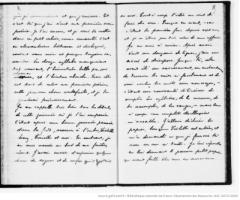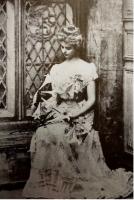
By Rebecca Boyd
January 2000 was a watershed moment in the history of research on Renée Vivien (1877-1909), the British-born French poet dubbed ‘Sappho 1900’ by posterity. It marked the long-awaited opening of the Fonds Salomon Reinach – a treasure-trove of documents on Vivien which had been meticulously compiled by Reinach in the interwar years, and donated to the Bibliothèque Nationale de France on one unusual condition: that they be kept under lock and seal until the year 2000.
Among stacks of original letters and handwritten copies of documents by and about Vivien, Reinach’s hoard included two unassuming little notebooks. Despite their modest appearance, they speak volumes: they are two of the journals Vivien kept over the course of the year 1893, in which the sixteen-year-old outlined her memoirs to date and her plans for the future. (The third known instalment is held in a private collection.) Titled Ma Vie et Mes Idées,[1] they offer invaluable insight into the ambitions and self-perception of the young Pauline Tarn – not yet renée as Renée Vivien, a pen-name she would only adopt 8 years later, in 1901. As of June 2023, scans of microfilm reproductions of the notebooks have been available on Gallica, making their contents freely accessible to anyone, anywhere in the world, with an Internet connection. Anyone who wishes to find out more about Vivien’s development as a writer, whether for academic purposes or out of personal interest, can do so… In theory. In practice, however, obstacles remain: the scans are difficult to navigate and Pauline’s handwriting is difficult to decipher, even for a technologically-proficient native French speaker with 20-20 vision – let alone for someone lacking any (or all) of those assets. As a result, the notebooks are easy to overlook for all but the most dedicated of Vivien scholars.
Yet interest in Vivien has been on the rise for a long time, and not only within academic circles. One of the first modern writers to frankly discuss love between women and to embrace an unapologetically lesbian identity, Vivien has long since been a cherished figure of queer counterculture. Like Oscar Wilde’s, her life story can easily be read as a tragic tale of martyrdom to the cause of what would come to be known as LGBTQ+ rights. In recent years, her œuvre has also been receiving more mainstream recognition – her works, once out of print, are now being published as mass-market paperbacks by Gallimard, Points, Talents Hauts, Rivages, and more. But this recognition has often gone hand in hand with the recycling of old clichés and salacious anecdotes that confine Vivien to the role of femme damnée[2] (the title of two Baudelaire poems about lesbians) and poète maudit(e)[3] – the very tropes from which Vivien sought to distance herself during her lifetime.

Ma Vie et Mes Idées tells a different story. Its pages are brimming with hope and ambition, with youthful sincerity reined in by a wry intellect, and, perhaps most importantly, with the seeds of many of her adult works. For this reason, over the course of Hilary Term 2024, I undertook the project of transcribing the first two instalments of Ma Vie et Mes Idées as part of the Bodleian Libraries Digital Editions course. The idea was to produce a more accessible and workable version of the existing scans, both for others and for my own doctoral research. To my surprise, however, I found the notebooks to be a much richer resource than I had anticipated. Most interestingly of all, their contents turned out to debunk many of the myths that surround Vivien – even, in some cases, myths that I, a Vivien scholar, had never thought to question.
For instance, there is the discovery of Sappho, Vivien’s self-appointed pagan patron saint. Echoes of Sappho’s fragmentary works and legendary life are everywhere in Vivien’s poetry; in 1903, she even published her own semi-scholarly, semi-creative translation of Sappho, preceded by a resolutely queer biography of the Ancient Greek poet. Vivien’s encounter with her illustrious predecessor is usually situated around the year 1900, and credited either to Natalie Clifford Barney, Vivien’s partner at the time, or to Eva Palmer, a friend of Clifford Barney’s with a pronounced interest in Ancient Greek culture. Yet Ma Vie et Mes Idées’s programme includes ‘une étude poétique sur les deux femmes poètes de la Grèce, Corinne et Sapho’[4] – of the latter, we are told that ‘c’est l’amour qui fera sa force et sa faiblesse, son génieinspiration et la perte de son inspiration même, c’est l’amour qui la fera mouvoir, chanter, vivre, vibrer, pleurer, ou s’extasier, c’est l’amour qui l'élèvera jusqu’aux Immortels.’[5] The programme also features a future collection of poetry entitled ‘Accords Éoliens,’[6] the dialect of Ancient Greek used by Sappho. In 1893, then, Pauline Tarn was already familiar with her future namesake and carving out a place for her in her as-yet unwritten œuvre. Even if she had not yet read Sappho’s fragments, it is clear from these passages that Vivien had the intention of doing so long before meeting Clifford Barney and Palmer.
This is just one example of the many surprises that Ma Vie et Mes Idées has in store. Its pages, with their crossings-out and blots of ink, offer not only invaluable background information on Renée Vivien’s beginnings as a writer, but also a fascinating insight into the life, thoughts, and dreams of a sixteen-year-old girl growing up between two empires in the twilight years of the nineteenth century. The digital edition, I hope, will enable many more to join me in eavesdropping, fondly, on ‘la Pauline d’aujourd’hui parl[ant] à la Pauline de demain.’[7]
[1] ‘My Life and My Ideas.’
[2] ‘damned woman.’
[3] ‘cursed poet’ – a phrase coined by Paul Verlaine in 1884.
[4] ‘a poetic study of Greece’s two women poets, Corinne [Korinna] and Sapho [Sappho].’
[5] ‘it is love that will be both her strength and her weakness, the source of her genius inspiration and of that inspiration’s very undoing, it is love that will make her move, sing, live, quiver, weep, or rejoice, it is love that will raise her to the ranks of the Immortals.’
[6] ‘Aeolian Harmonies.’
[7] ‘the Pauline of today speak[ing] to the Pauline of tomorrow.’